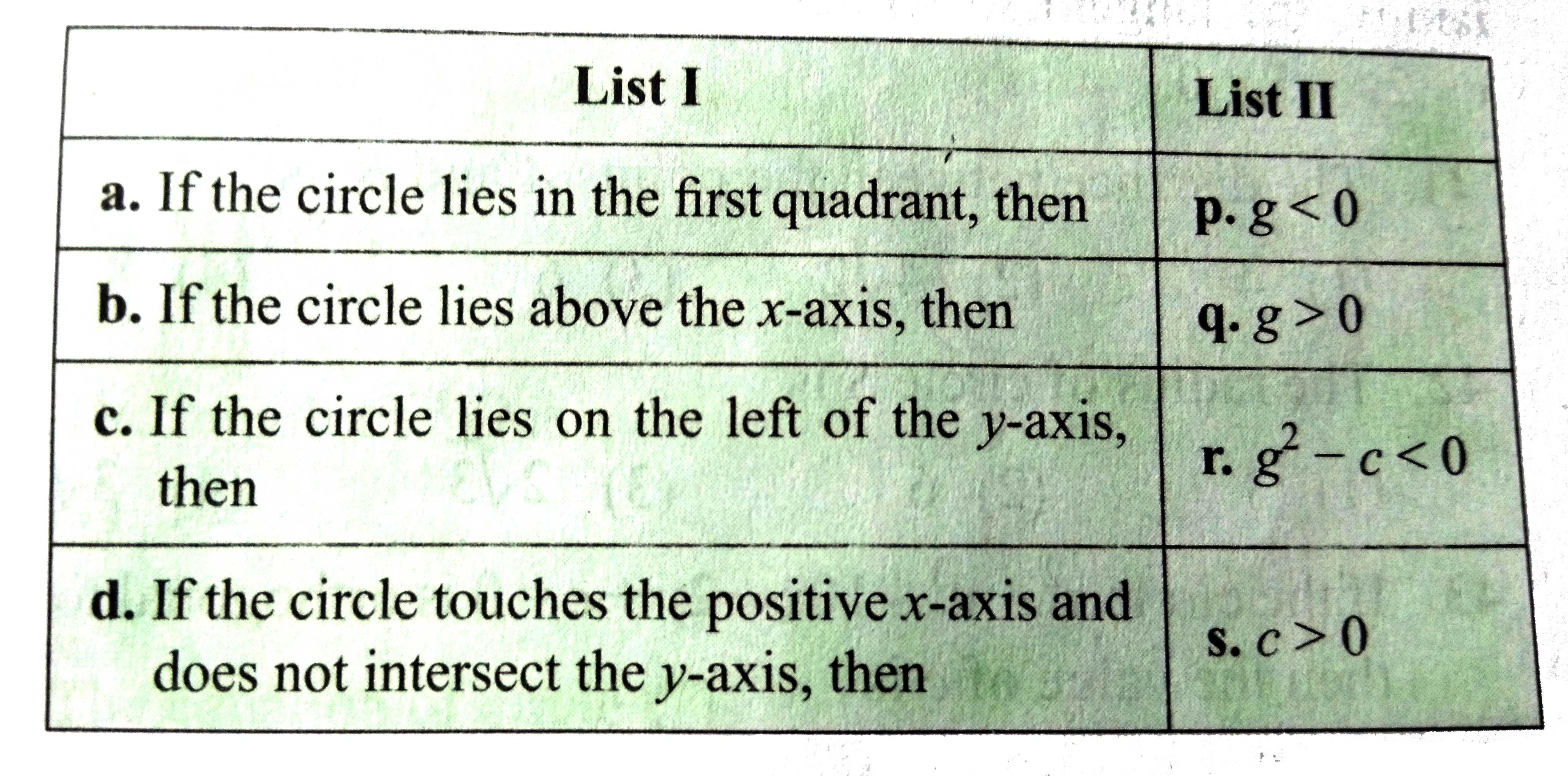Let x2+y2+2gx+2fy+c=0 be an equation of circle. Match the following lists :
 Solution in Tamil
Solution in Tamil
The correct Answer is:a→p;r,s;b→r,s;c→q,s;d→p,s
a. The point (−g,−f) lies in the first quadrant. Then g<0 and f<0 . Also , the x- and y-axes must not cut the circle.
Solving the circle and the x-axis, we have x2+2gx+c=−, which must chave imaginary roots. So, g2−c<0. Then c must be positive . Also, f2−c<0
b. If the circle lies above the x-axis, then x2+2gx+c=0 must have imaginary roots. Therefore, g2−c<0 and c>0.
c. The point (−g,−f) lies in the third or fourth quadrant. Then g>0. Also, the y -axis must not cut the circle.
Solving the circle and the y-axis, we have y2+2gy+c=0, which must have imaginary roots. Then f2−c<0. So, c must be positive.
d. x2+2gx=c=0 must have equal roots. Then g2=c. Hence, c>0.
Also, −g>0 or g<0.
Topper's Solved these Questions
Similar Questions
Tangents drawn from the point P(1,8) to the circle x2+y2−6x−4y−11=0 touch the circle at the points A&B ifR is the radius of circum circle of triangle PAB then [R]-
View SolutionConsider a G.P. with first term (1+x)n, |x|<1, common ratio 1+x2 and number of terms (n+1). Let 'S' be sum of all the terms of the G.P., then
The coefficient of xn is 'S' is02:11View SolutionIf ax+by=10 is the chord of minimum length of the circle (x−10)2+(y−20)2=729 and the chord passes through (5,15) then the value of (4a+2b) is
01:31View SolutionMatch the following lists:
 02:45View Solution
02:45View SolutionDetermine the point of symmetry of a regular hexagon.
02:17View SolutionDtermine the images of the following figure about the given line :
05:41View SolutionMatch the following Column A to Column B
 02:10View Solution
02:10View SolutionMatch the following Column A to Column B
 02:17View Solution
02:17View SolutionMatch the following Column A to Column B
 02:10View Solution
02:10View SolutionThe inequation represented by the graph given below is :
01:50View SolutionThe inequation that best describes the graph given below is _________
03:12View SolutionThe inequation that best describes the following graph is _________
08:58View SolutionAt x=0, value of (dy)/(dx) is : ltimg src="https://d10lpgp6xz60nq.cloudfront.net/physics_images/ALN_PHY_R04_E01_024_Q01.png" width="80%"gt
04:00View SolutionMatch the followings (column I with column II)
ltimg src="https://d10lpgp6xz60nq.cloudfront.net/physics_images/NCERT_BIO_XI_C03_E01_011_Q01.png" width="80%"gt05:46View SolutionMatch the following:
ltimg src="https://d10lpgp6xz60nq.cloudfront.net/physics_images/NCERT_BIO_XI_C04_E01_014_Q01.png" width="80%"gt06:52View SolutionMatch column I with column II
ltimg src="https://d10lpgp6xz60nq.cloudfront.net/physics_images/NCERT_BIO_XI_C16_E01_002_Q01.png" width="80%"gt06:14View Solution

